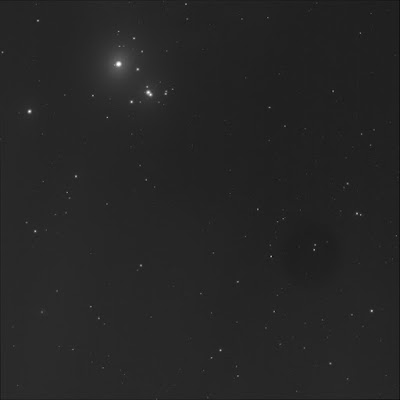Should be lots of doubles here.
The plan is to maybe do some HDR processing...
I asked for some fast exposures.
Luminance only, ½ second subexposures, 12 stacked shots. FITS Liberator, GIMP. North is up; left is east.
Bright iota Orionis at the top-left dominates the scene. The tiny dim C companion is visible, clearly, to the left or east.
If you look carefully in the quick shot, at the 7 o'clock position, you can JUST make out B. Woo!
STF 747 aka HR 1887 is the wide bright pair of stars south-west of iota. Nearly equal but B, slightly dimmer, is obviously at the 4 o'clock position.
West of 747 is Struve 745. It's a triple. B is close, NNW. C is dimmer, 2 to 3 times the AB distance, along a NW line.
Near the right edge of the image, mid-point and down a bit, are two tantalising pairs. Both about the same split distance as 747. Faint though.
The upper pair ENG 21. Nearly equal stars, the west is slightly dimmer. Almost exactly the 747 separation. SkyTools 3 Pro says it's 44.4".
Down and left of ENG is a slightly wider pair, a touch dimmer, with the brighter element to the south. Nearly N-S alignment. This is STF 735. ST3P says it's a triple but there's no star at the location shown in the chart (mag 11.6)... Hmm.
Hey! Look at the fuzzy star near the bottom-left. That's the multi-star system J 798, which I don't think we're splitting here. But SkyTools shows it in the middle of the diffuse nebula NGC 1999. Also known as vdB 46, LBN 979, and Bernes 122.
Sure looks like HD 37091 is a double...
§
Oh yes. And the offsetting worked. Both images shifted a little bit to the east.




No comments:
Post a Comment